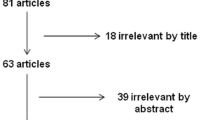Abstract
Thalassemia major is a common cause of skeletal morbidity, as shown by the increased fracture risk in thalassemic patients. The etiology of this bone disease is multifactorial and culminates in a state of increased bone turnover with excessive bone resorption and remodeling. Despite hormonal replacement therapy, calcium and vitamin D administration, effective iron chelation, and normalization of hemoglobin levels, patients with thalassemia major continue to lose bone mass. The increased bone turnover rate observed in thalassemic patients justifies the use of powerful anti-resorption drugs, such as bisphosphonates. To date, alendronate, pamidronate, and zoledronate seem to be effective in increasing bone mineral density and normalizing bone turnover, but more trials are necessary to evaluate their efficacy in reducing fracture risks in larger thalassemic populations.
Similar content being viewed by others
References
Ruggiero L, De Sanctis V. Multicentre study on prevalence of fractures in transfusion-dependent thalassaemic patients. J Pediatr Endocrinol Metab 1998, 11: 773–8.
Vogiatzi MG, Macklin EA, Fung EB, et al. Prevalence of fractures among the Thalassemia syndromes in North America. Bone 2006, 38: 571–5.
Lasco A, Morabito N, Gaudio A, Buemi M, Wasniewska M, Frisina N. Effects of hormonal replacement therapy on bone metabolism in young adults with beta-thalassemia major. Osteoporos Int 2001, 12: 570–5.
Voskaridou E, Kyrtsonis MC, Terpos E, et al. Bone resorption is increased in young adults with thalassaemia major. Br J Haematol 2001, 112: 36–41.
Jensen CE, Tuck SM, Agnew JE, et al. High incidence of osteoporosis in thalassaemia major. J Pediatr Endocrinol Metab 1998, 11 (Suppl 3): 975–7.
Wonke B, Jensen C, Hanslip JJ, et al. Genetic and acquired predisposing factors and treatment of osteoporosis in thalassaemia major. J Pediatr Endocrinol Metab 1998, 11 (Suppl 3): 795–801.
Lasco A, Morabito N, Gaudio A, et al. Osteoporosis and beta-thalassemia major: role of the IGF-I/IGFBP-III axis. J Endocrinol Invest 2002, 25: 338–44.
Anapliotou ML, Kastanias IT, Psara P, Evangelou EA, Liparaki M, Dimitriou P. The contribution of hypogonadism to the development of osteoporosis in thalassaemia major: new therapeutic approaches. Clin Endocrinol (Oxf) 1995, 42: 279–87.
Soliman AT, El Banna N, Abdel Fattah M, ElZalabani MM, Ansari BM. Bone mineral density in prepubertal children with beta-thalassemia: correlation with growth and hormonal data. Metabolism 1998, 47: 541–8.
de Vernejoul MC, Pointillart A, Golenzer CC, et al. Effects of iron overload on bone remodeling in pigs. Am J Pathol 1984, 116: 377–84.
De Sanctis V, Pinamonti A, Di Palma A, et al. Growth and development in thalassaemia major patients with severe bone lesions due to desferrioxamine. Eur J Pediatr 1996, 155: 368–72.
Carmina E, Di Fede G, Napoli N, et al. Hypogonadism and hormone replacement therapy on bone mass of adult women with thalassemia major. Calcif Tissue Int 2004, 74: 68–71.
Suda T, Nakamura I, Jimi E, Takahashi N. Regulation of osteoclast function. J Bone Miner Res 1997, 12: 869–79.
Fleisch H. Bisphosphonates: mechanisms of action. Endocr Rev 1998, 19: 80–100.
Gatti D, Adami S. New Bisphosphonates in the Treatment of Bone Diseases. Drugs Aging 1999, 15: 285–96
Morabito N, Lasco A, Gaudio A et al. Bisphosphonates in the treatment of thalassemia-induced osteoporosis. Osteoporos Int 2002, 13: 644–9.
Pennisi P, Pizzarelli G, Spina M, Riccobene S, Fiore CE. Quantitative ultrasound of bone and clodronate effects in thalassemia-induced osteoporosis. J Bone Miner Met 2003, 21: 402–8.
Voskaridou E, Terpos E, Spina G et al. Pamidronate is an effective treatment for osteoporosis in patients with beta-thalassaemia. Br J Haematol 2003, 123: 730–7.
Perifanis V, Vyzantiadis T, Vakalopoulou S, et al. Treatment of beta-thalassaemia-associated osteoporosis with zoledronic acid. Br J Haematol 2004, 5: 91–2.
Voskaridou E, Anagnostopoulos A, Konstantopoulos K, et al. Zoledronic acid for the treatment of osteoporosis in patients with beta-thalassemia: results from a single-center, randomized, placebo-controlled trial. Haematologica 2006, 91: 1193–202.
Otrock ZK, Azar ST, Shamseddeen WA, et al. Intravenous zoledronic acid treatment in thalassemia-induced osteoporosis: results of a phase II clinical trial. Ann Hematol 2006, 85: 605–9.
Gilfillan CP, Strauss BJ, Rodda CP, et al. A randomized, double-blind, placebo-controlled trial of intravenous zoledronic acid in the treatment of thalassemia-associated osteopenia. Calcif Tissue Int 2006, 79: 138–44.
Krueger CD, West PM, Sargent M, Lodolce AE, Pickard AS. Bisphosphonate-induced osteonecrosis of the jaw. Ann Pharmacother 2007, 41: 276–84.
Prentice A, Parsons TJ, Cole TJ. Uncritical use of bone mineral density in absorptiometry may lead to size-related artifacts in the identification of bone mineral determinants. Am J Clin Nutr 1994, 60: 837–42.
Compston JE. Bone density: BMC, BMD, or corrected BMD? Bone 1995, 16: 5–7.
Kröger H, Kotaniemi A, Vainio P, Alhava E. Bone densitometry of the spine and femur in children by dual-energy x-ray absorptiometry. Bone Miner 1992, 17: 75–85.
Carter DR, Bouxsein ML, Marcus R. New approaches for interpreting projected bone densitometry data. J Bone Miner Res 1992, 7: 137–45.
Author information
Authors and Affiliations
Corresponding author
Rights and permissions
About this article
Cite this article
Gaudio, A., Morabito, N., Xourafa, A. et al. Bisphosphonates in the treatment of thalassemia-associated osteoporosis. J Endocrinol Invest 31, 181–184 (2008). https://doi.org/10.1007/BF03345587
Accepted:
Published:
Issue Date:
DOI: https://doi.org/10.1007/BF03345587




